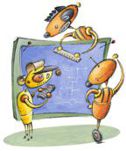Date: April 4, 1997
Speaker: Jim Gray, Microsoft Research
I/O Revisited -- Why and How
Abstract:
The talk begins with a short survey of some BIG databases we face in the next decade. The web is less than a Tearbyte of HTML. Satellite image databases grow that much in a few hours. The Sloan Sky Survey will be 40 terabytes, EOS/DIS will be 15 Petabytes. Then there is the global digital library that Raj and others talk about. After 15 minutes of this motivation, discussion shifts to simple storage metrics: MOX and SCANS are better storage performance metrics than KOX (KB objects accessed per second). When combined with $/MOX and $/SCAN, they show why tape is doomed as a near-line storage device. The talk revisits the 5 minute rule for trading off DRAM for disk accesses. Then it pops back to the global level and assess our progress in building reliable storage systems (good) and HSMs (abysmal). The talk concludes with a short demo of the NT Clusters (Wolfpack) design for highly-available storage servers.
Bio:
Dr. Gray is a specialist in database and transaction processing computer systems. At Microsoft his research focuses on scaleable computing: building super-servers and workgroup systems from commodity software and hardware. Prior to joining Microsoft, he worked at Digital, Tandem, IBM and AT&T on database and transaction processing systems. He is editor of the Performance Handbook for Database and Transaction Processing Systems, and co-author of Transaction Processing Concepts and Techniques. He is a Member of the National Academy of Engineering, Fellow of the ACM, a member of the National Research Council's Computer Science and Telecommunications Board, Editor in Chief of the VLDB Journal, Trustee of the VLDB Foundation, and Editor of the Morgan Kaufmann series on Data Management.
SDI / LCS Seminar Questions?
Karen Lindenfelser, 86716, or visit www.pdl.cmu.edu/SDI/
